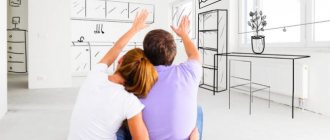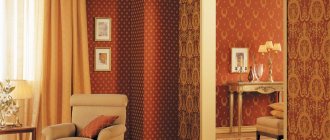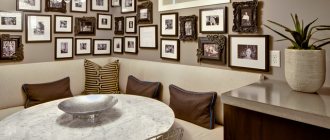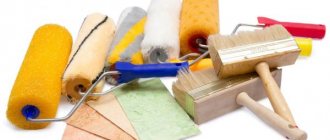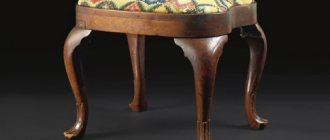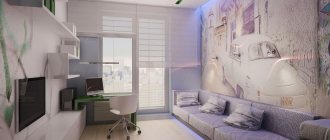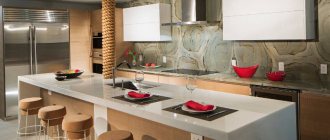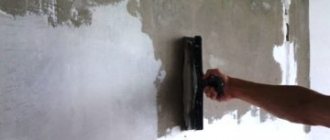The fashion for walls decorated with wood and wood materials is not going away. Wood adds warmth and comfort to the interior like no other material. It is present in most interior styles - modern and classic.
Wooden decors decorate palace chambers and country houses, and are present on the walls of interiors originally from the sunny province of Provence and distant, cold Scandinavia. Wood makes classic interiors elegant and fashionable city apartments in an industrial loft style or decorated in a minimalist spirit warmer, more comfortable.
How to use wooden panels for interior wall decoration, photos of interesting arrangements, selection of design to match the interior style - these issues are discussed below.
Where are wood panels used?
Today, wooden and tree-like panels are rarely used to decorate the walls of an entire apartment or room. Typically cladding is used on one wall, for example:
- around doorways;
- around window joinery;
- for the walls of a large wardrobe;
- for the section of wall behind the bed, sofa, TV, bar counter, kitchen island;
- for slanting walls, pillars, columns, niches;
- in bathrooms, saunas;
- on glazed balconies and loggias.
Wood will give the interior a friendly, cozy character. To give interior elements or walls a fashionable English or Provencal style, the wall is finished from below and only up to the height of the window sill and sink. Wooden wall panels are placed in different directions:
- vertical;
- horizontally;
- obliquely, giving the finish a modern character.
Modern wood wall panels on the walls - photo
Possibility of installing wooden panels
Cladding walls with clapboard covers a small number of projects. For example, the designer can lay it horizontally, vertically or in a herringbone pattern. But if you use your imagination, a combination of various types of lining and additional patterns is not excluded. This will perfectly complement and decorate any interior, making it simply magnificent.
As with any other construction or finishing work, installation of wooden panels begins with choosing the appropriate tool and preparing the walls.
Necessary tools: • A hammer drill if the wall on which the panel is mounted is concrete, or a drill if the base is lined with brickwork. • Screwdriver. It will be needed if a wooden structure is cladding. • Jigsaw or hacksaw. These tools will help speed up installation significantly. • Level and tape measure. Thanks to the level, the overall structure will have perfectly even proportions.
Preparing the surface for wood paneling
No special preparation of the walls is required. We can only say that it is necessary to remove strongly protruding plaster, if any, and clean the surface of fungus or mold, treating it with special means.
The installation process itself is not complicated. First, the sheathing is installed. It can be made from either metal or wooden profiles. In the resulting space, you can lay insulation or carry out some kind of communication. If the sheathing is made of wood, be sure to treat it with additional substances, such as primer, to prevent mold and mildew.
Methods of fastening wooden panels
Before starting work, it is important to decide on the choice of method of fastening the panels. Everyone can choose a convenient and more familiar one for themselves. The board itself is a kind of fastening system, where on one side there is a small recess, and on the other there is a protruding tenon, which is easily inserted into the next lining.
The panels are fastened in two ways: externally or secretly. For both, you can use nails, clamps or decorative screws. The most important thing is to try to work very carefully so that there is minimal impact on the board, otherwise it may crack. With the hidden method, the lining is attached to the sheathing at the point where it joins the tenon. If nails are to be exposed, then the panel is nailed to the sheathing with nails with small heads, evenly distributing them along the entire perimeter. This, of course, is the fastest and easiest way, but from an aesthetic point of view, this method is more suitable for covering some kind of utility room.
For high-quality and reliable fastening, clamps are available. Such fasteners are made of galvanized steel and have different sizes. The size of the clamp is selected individually, depending on the type of wooden panel and its width. One part of the clamp is cut into the grooves of the board, and the other is screwed to the sheathing.
Watch the video: Wooden panels
Do not forget to lay out the panels in a dry room for a couple of weeks before starting work. If they are not dry enough, you need to continue drying. Never work with wet boards.
Useful articles
- Wall panels for interior decoration
- Modern materials for soundproofing walls in an apartment
- We understand the characteristics of OSB sheet
- Secrets of choosing a good window sill
- What flooring to use for the terrace
- Ideas for using natural stone in the interior
Processing and installation
In the interior of cottages, houses, and apartments in the Scandinavian style, solid wood paneling is very popular. Typically these are boards with dimensions:
- thickness – 1.2-2 cm;
- length – 2.5-2.7 m;
- width – 9-10 cm.
Most popular wood:
- pine;
- spruce;
- beech;
- ash;
- oak.
The edges of the boards are made with grooves, allowing you to create a tight connection. The paneling creates a recognizable wood grain pattern on the wall. The surface of the boards is processed and comes in various types:
- smooth;
- profiled;
- with grooves.
Installation of wall panels is carried out on a mounting frame. The frame must be purchased complete with panels - a competent seller will advise some installation points:
- what is the distance between the frame slats (usually 40-60 cm);
- will help you calculate the required number of planks.
The return of wood paneling to modern interiors occurred thanks to the emergence of modern finishing materials:
- various impregnations;
- varnishes;
- oils;
- waxes.
Thanks to impregnations, pine panels, for example, can be given the appearance of precious exotic types of wood, for example, the popular color of teak and mahogany.
Types of wood panels
There are a huge number of options for this finishing method:
in the form of decorative tinted plates made of solid wood, which are most often made from coniferous wood;
in the form of re-glued solid lamella panels;
with a three-layer design that has an outer valuable layer.
The most expensive in terms of cost, but at the same time very prestigious, are wooden plates made from solid natural wood. This finishing material has its own “whims”, for example, experts do not recommend using it for cladding rooms where there is a high level of humidity; such a place is the kitchen, where it is better to install plastic wall panels that are not afraid of moisture.
Now there are more economical panel options. These include glued-type plates. In their production, an innovative special technology is used, which allows gluing together thin layers of wood located perpendicular to each other.
Glued panels can also be assembled from valuable wood, using veneer bars with a face layer.
At the moment, artificially aged options are very popular. So pay attention to this option, it speaks of the taste of the owners of the house who selected this type of interior decoration.
Using carved plates, you will give a luxurious and rich look to the entire room. Thanks to the chosen type of wooden plates, the walls can be made light and graceful, or vice versa - majestically massive.
Often the walls are decorated with panels made of valuable wood species such as mahogany, alder, oak, cedar and maple. To give the surface greater shine and at the same time protect it from external factors - ultraviolet rays, moisture and other things - special wax or acrylic varnish is usually used.
How to choose panels to match your interior style?
It is important to choose the right trim to match the decor style of the room.
Scandinavian or English style
Scandinavian or English style can be given to the interior using paint that creates a certain background. Usually paint is used in shades:
- white;
- mint;
- pistachio;
- blue color.
Pastel wood paneling will allow the interiors to look cozy and modern. The light color visually makes the board modern while maintaining a cozy appearance.
Interior in Scandinavian style with panels painted white - photo
Sea style
An interesting effect is achieved if the wooden paneling is painted in bright colors, for example, red or blue. Such arrangements are used in Scandinavian and maritime style interiors.
Provence
For a Provence interior, wooden wall cladding can be painted in the following colors:
- white,
- soft blue,
- light gray
- light pink
An excellent solution is to create the effect of artificial aging of wood.
Wooden wall cladding in Provence style - photo
Loft style
In industrial design, loft wood appears in its natural form. Painting will be unnecessary; you need to use appropriate impregnation, oils, and varnishes to highlight the natural color of the wood and protect it from moisture and pests.
Wooden walls in loft style - photo
Types of coatings for wood panels
For greater practicality and durability, as well as for a more attractive and radiant appearance, various coatings are applied to the wall made of wooden panels:
To prevent the negative effects of moisture on wooden panels, various types of varnishes, wax and many other compounds that are safe for health are used.
Embossing. In other words, this is a pressing process that provides the panels with additional strength. Also, using a hot press, various original ornaments and designs are applied to the panels, which are later painted during production.
Laminate. Laminating decorative film primarily protects the surface of wall panels from fading under the influence of ultraviolet rays, and also protects them from various types of influences - chemical, thermal, mechanical and others.
Types of panels
The cladding is made of various panels, differing in color, design and material from which they are made.
Tree-like MDF panels
If you like wood but cannot use natural boards, you should find a wide selection of wood-like boards in a variety of materials. Wood-like slabs are covered with veneer and finished in another way that imitates the texture and color of natural wood.
Wood paneling, photo
A popular cladding option is MDF board. These are medium-density wood boards that are relatively easy to install and keep clean.
Standard slab sizes, cm:
- thickness – 0.07-0.12;
- width – 12.5-32.5;
- length – 90-260.
The wide range of sizes gives many possibilities for the arrangement of the paneling in the interior.
Finishing panels for walls are finished in various ways, imitating pine, oak, cherry, and exotic wood. The slabs cover:
- opaque paints;
- film;
- laminate;
- natural veneer.
Veneered wall panels
Beautiful, elegant wall coverings blend naturally with modern and traditional interiors. If you need to quickly change the interior, give it strong, distinctive features, you can use veneered wall panels.
The panels, separated from each other by a thin aluminum strip, do not create a homogeneous space and form an orderly interior. Natural veneer combines beautifully with other materials, such as laminated boards.
Veneered panels, photo
The photo above shows wall panels made of 8 mm thick MDF board, covered with natural modified veneer 0.6 mm thick, protected with transparent polyurethane varnish. The connecting element is a decorative aluminum strip. The panels are intended for use in rooms where humidity does not exceed 70%; they should not be exposed to high temperatures, for example, used as a fireplace body.
Veneered cladding on the walls creates a large, dramatic surface without division, characteristic of natural boards. Veneer thickness – 0.6-3 mm. Natural veneer is produced in such a way that it preserves the texture and natural tones of the wood. Veneer is obtained from domestic wood species.
The most popular natural veneers are:
- alders;
- beech;
- birch;
- ash
- pine trees;
- bleached oak;
- species of exotic origin - mahogany, ebony.
Wall cladding finished with natural veneer, photo
Modified veneer has a rich texture, a distinct striped pattern, the result of hundreds of gluing layers of veneer and cutting it into thin strips parallel to the gluing. Modified veneer made from:
- wenge;
- ebony;
- zebrano;
- Finnish birch;
- teak;
- oak
OSB board
In industrial interiors and youth rooms, you can use OSB boards. You need to choose a board of only high quality, which is usually considered as a building material for residential premises. You definitely need to check the quality certificates; not all OSB boards are harmless and suitable for living rooms. The pattern of the OSB board allows you to create a unique interior atmosphere.
Types of wall decoration for a wooden house
If the log house itself has an attractive appearance, it is rarely sheathed. In this case, it makes sense to reduce the cost of interior finishing: sand the log or timber and tint it. Only the floors should be varnished: the varnish will prevent abrasion of the wood. It is best to cover the walls and ceiling with tinting antiseptics or water-based paints. They do not paint over the texture of the wood, but only give it a tint, better showing the pattern. You will still have to use antiseptics to maintain the attractive appearance of the wood.
You will most likely have to use antiseptics, you can take them with a coloring pigment, at the same time highlight the beauty of the wood pattern
If the log or beam is normal, the caulking seam looks bad, it is sealed with a twisted cord, and the walls are finished in the same way - sanded and tinted. Everything also looks good, and the cord in the groove serves as an additional guarantee against drafts.
Ugly seams from caulk can be sealed with cord - it looks attractive, and even prevents drafts
How to cover the walls of a wooden house inside
If the frame is so crooked or old that sanding will not help, you will have to make the interior decoration of the wooden house from lining, wall panels, drywall or other material.
For any of these materials, it is better to make a lathing: this way you can level the surface of the walls. In addition, behind the sheathing there is space for free air circulation. In a wooden house, this is important, since only dry wood does not rot or blacken. Free air circulation between the finishing material and the wall will maintain their normal condition.
The sheathing in a house made of timber or logs is done in the same way: you need to remember that it must “float” so that the finishing does not fly off
The space behind the sheathing is also used for laying communications - electrical wiring, for example. In a wooden house it should be made in non-flammable pipes, so you need a fair amount of space for it. If necessary, you can put insulation there if your house is cold. If you spend little on heating and the house is warm, it is better not to use any additional materials: neither insulation nor vapor barrier. Wood itself does an excellent job of maintaining stable humidity in the house, and extra layers only upset the balance.
Not everyone likes attaching trim to the sheathing: if an animal or insects settle behind the sheathing, it is difficult to get rid of them. In this case, you can level the surface of the logs by removing the protruding parts and nail the finish to this surface. A perfectly flat surface is difficult to achieve, but possible. The gaps between the finishing material and the wall, which in this case still exist, were once covered with clay. It will both provide thermal insulation and protect against drafts. Technologically this is incorrect, but they do it too.
Whatever materials are used for cladding the walls of a wooden house inside, there should be a gap of at least 2-4 cm to the ceiling. For a “young” log house, this is insurance against shrinkage. For the old one - a gap to compensate for changes in the geometry of the wood. She breathes all her life: sometimes she gains moisture and swells, sometimes she dries out. The gap under the ceiling will allow the wood to easily expand or shrink, without consequences for the finish. If this is not done, then either cracks will appear or the finishing will bend/rip out. To prevent the gap from “hurting the eye,” it is covered with a ceiling plinth. It is only nailed to the stream, it is only leaned against the wall. In this case, all movements will be invisible.
Read about the interiors of a wooden house and methods of interior decoration in the article “Design of a wooden house inside in photos and videos”
Unconventional options for wall cladding with wood - photos of interiors
Wooden and wood-like wall finishing materials help create a muted, cozy, warm interior and allow you to show the natural beauty of wood in an unconventional way. The variety of types, finishes, available widths of boards and slabs offers unlimited arrangement possibilities.
Don't like traditional paneling? There are other options that are more interesting. Modern wooden wall finishing materials have different structures. The decorative panels shown in the photo below consist of wooden cubes that form an irregular texture. Thanks to this, the surface looks interesting and varied.
An interesting option is to decorate the walls with wooden boards unevenly, highlighting certain areas, giving the surface a unique look. The photo below shows a TV wall decorated in a rustic style like a window with carved shutters.
An interesting, unique effect is obtained by combining different boards, if none of the panels is identical to the other. Regardless of whether the paint is peeling or the board is cracked, they look natural.
Natural boards cut into pieces look very impressive, but a carpenter needs to do some work here.
By skillfully using various dyes, you can play with colors beautifully. A multi-colored wall looks very interesting and elegant.
The manufacturer B & N Industries, which produces models with carved patterns, took a whimsical and imaginative approach to the manufacture of wooden paneling. There are 3 types of reclaimed wood used here, obtained from cutting wine barrels and black walnut wood. Old wood has a unique patina.
Lovers of naturalness will love the spectacular decorative slabs consisting of wooden disks. They show the cross-section of the wood and cracking. Spectacular finishing adds naturalness and character to the interior.
Advantages and disadvantages of wall finishing
Wooden panels
Related article: Construction of a homemade jacuzzi
I was immediately attracted by the fact that any room can be covered with wooden panels, and at the same time, decorative elements easily fit into any design and are perfectly combined with other finishing materials. For myself, I have identified several special advantages of wood panels:
- An attractive aesthetic appearance - comfort and sophistication is the main transformation of a room after decorating the walls with wooden panels
- Wall boards are environmentally friendly - since wood is used in production, which is a natural material and also has the properties of regulating the microclimate in the room
- Practicality - caring for the interior is quite simple; if it gets dirty, just wipe the surface with a damp cloth
- Simple installation - no special skills are required for installation; it is enough to know the correct installation technology in order to complete all the finishing yourself
- Low thermal conductivity - thanks to this, in the winter season the room is able to retain heat longer. At the same time, in the summer, wooden trim helps keep you cool.
- Good sound insulation - thanks to sound absorption, the room becomes even more comfortable
Wooden panels for interior decoration
Important! Carved wooden panels are in great demand in the interior of a country mansion and even an office space. Thanks to this design, the room becomes not only cozy, but very noble and original. Some carved patterns can emphasize the wealth and style of the owner of the house.
- Durability – thanks to their resistance to mechanical and natural influences, the panels can last for decades. And with proper care, they retain their original appearance for a very long time.
- Preparatory work for walls is carried out much faster than, for example, before painting. The fact is that wooden slabs do not require perfect alignment of the walls or ceiling
- In the modern construction market there are a huge number of textures, shapes and colors of panels. There are even carved wooden panels, which are made from high quality wood and then applied with a pattern.
Related article: Technology of finishing and draping walls with fabric
Wooden wall panels
I have repeatedly observed wall elements made of wood, which are used in the interior along with a combination of other materials. It looks very attractive, and most importantly, it becomes possible to complement or transform the design of the room without much effort and at any convenient time.
We install wooden panels ourselves
Of course, like any other material, wooden slabs and panels have some disadvantages:
- It is not recommended to use wall elements for interior cladding of rooms with high levels of humidity - wood is susceptible to the formation of mold and mildew. There are special impregnations that allow you to maintain stability for some time, but this effect is still not permanent.
- Anti-corrosion treatment is a mandatory procedure that is carried out at certain intervals
Main features when installing any wood panels
features of installation of wooden panels
Wooden panels, whether for the ceiling or for the wall, must lie for at least a day in the room where they are planned to be installed.
It is necessary to take into account that covering the ceiling in the kitchen or in any other room with panels must be done at room temperature.
For any installation method, the surface must be flat (lathing), as well as clean and dry, this affects the quality and durability.
If the panels used are very expensive, you should not take on finishing the ceiling with clapboard or wood yourself. In most cases, when work is carried out by an inexperienced installer, the cost of the total rejected panels exceeds the cost of the work of a theoretically hired professional for finishing.
Of course, the quality of the final cladding in the second case will be much higher - without the slightest gaps, with complete hiding of the defects of the main surface. In addition, wooden panels will be installed in a short time.
